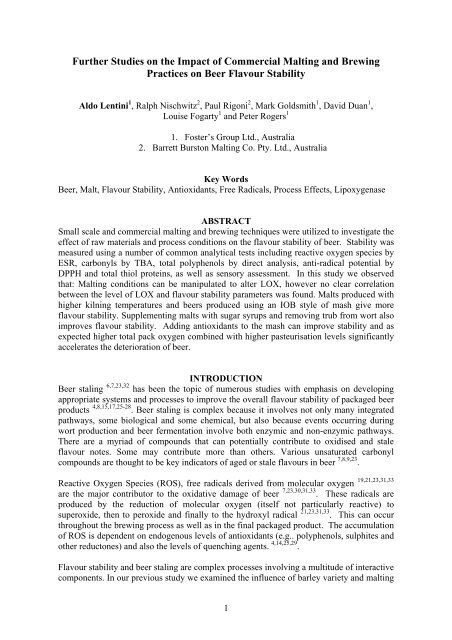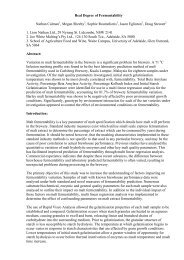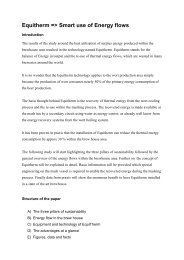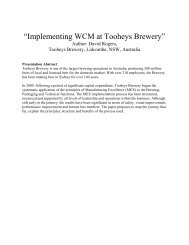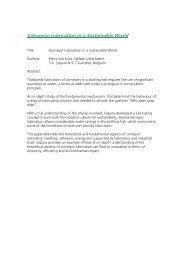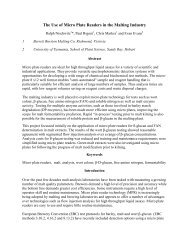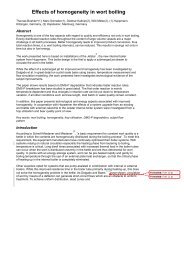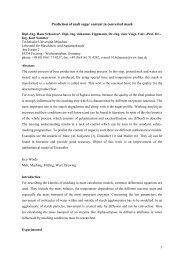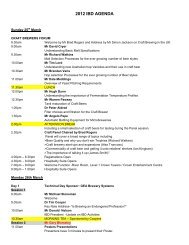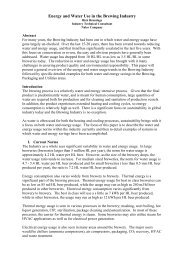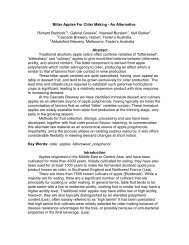Further Studies on the Impact of Commercial Malting and Brewing ...
Further Studies on the Impact of Commercial Malting and Brewing ...
Further Studies on the Impact of Commercial Malting and Brewing ...
Create successful ePaper yourself
Turn your PDF publications into a flip-book with our unique Google optimized e-Paper software.
<str<strong>on</strong>g>Fur<strong>the</strong>r</str<strong>on</strong>g> <str<strong>on</strong>g>Studies</str<strong>on</strong>g> <strong>on</strong> <strong>the</strong> <strong>Impact</strong> <strong>of</strong> <strong>Commercial</strong> <strong>Malting</strong> <strong>and</strong> <strong>Brewing</strong><br />
Practices <strong>on</strong> Beer Flavour Stability<br />
Aldo Lentini 1 , Ralph Nischwitz 2 , Paul Rig<strong>on</strong>i 2 , Mark Goldsmith 1 , David Duan 1 ,<br />
Louise Fogarty 1 <strong>and</strong> Peter Rogers 1<br />
1. Foster’s Group Ltd., Australia<br />
2. Barrett Burst<strong>on</strong> <strong>Malting</strong> Co. Pty. Ltd., Australia<br />
Key Words<br />
Beer, Malt, Flavour Stability, Antioxidants, Free Radicals, Process Effects, Lipoxygenase<br />
ABSTRACT<br />
Small scale <strong>and</strong> commercial malting <strong>and</strong> brewing techniques were utilized to investigate <strong>the</strong><br />
effect <strong>of</strong> raw materials <strong>and</strong> process c<strong>on</strong>diti<strong>on</strong>s <strong>on</strong> <strong>the</strong> flavour stability <strong>of</strong> beer. Stability was<br />
measured using a number <strong>of</strong> comm<strong>on</strong> analytical tests including reactive oxygen species by<br />
ESR, carb<strong>on</strong>yls by TBA, total polyphenols by direct analysis, anti-radical potential by<br />
DPPH <strong>and</strong> total thiol proteins, as well as sensory assessment. In this study we observed<br />
that: <strong>Malting</strong> c<strong>on</strong>diti<strong>on</strong>s can be manipulated to alter LOX, however no clear correlati<strong>on</strong><br />
between <strong>the</strong> level <strong>of</strong> LOX <strong>and</strong> flavour stability parameters was found. Malts produced with<br />
higher kilning temperatures <strong>and</strong> beers produced using an IOB style <strong>of</strong> mash give more<br />
flavour stability. Supplementing malts with sugar syrups <strong>and</strong> removing trub from wort also<br />
improves flavour stability. Adding antioxidants to <strong>the</strong> mash can improve stability <strong>and</strong> as<br />
expected higher total pack oxygen combined with higher pasteurisati<strong>on</strong> levels significantly<br />
accelerates <strong>the</strong> deteriorati<strong>on</strong> <strong>of</strong> beer.<br />
INTRODUCTION<br />
Beer staling 6,7,23,32 has been <strong>the</strong> topic <strong>of</strong> numerous studies with emphasis <strong>on</strong> developing<br />
appropriate systems <strong>and</strong> processes to improve <strong>the</strong> overall flavour stability <strong>of</strong> packaged beer<br />
products 4,8,15,17,25-28 . Beer staling is complex because it involves not <strong>on</strong>ly many integrated<br />
pathways, some biological <strong>and</strong> some chemical, but also because events occurring during<br />
wort producti<strong>on</strong> <strong>and</strong> beer fermentati<strong>on</strong> involve both enzymic <strong>and</strong> n<strong>on</strong>-enzymic pathways.<br />
There are a myriad <strong>of</strong> compounds that can potentially c<strong>on</strong>tribute to oxidised <strong>and</strong> stale<br />
flavour notes. Some may c<strong>on</strong>tribute more than o<strong>the</strong>rs. Various unsaturated carb<strong>on</strong>yl<br />
compounds are thought to be key indicators <strong>of</strong> aged or stale flavours in beer 7,8,9,23 .<br />
Reactive Oxygen Species (ROS), free radicals derived from molecular oxygen 19,21,23,31,33<br />
are <strong>the</strong> major c<strong>on</strong>tributor to <strong>the</strong> oxidative damage <strong>of</strong> beer 7,23,30,31,33 . These radicals are<br />
produced by <strong>the</strong> reducti<strong>on</strong> <strong>of</strong> molecular oxygen (itself not particularly reactive) to<br />
superoxide, <strong>the</strong>n to peroxide <strong>and</strong> finally to <strong>the</strong> hydroxyl radical 21,23,31,33 . This can occur<br />
throughout <strong>the</strong> brewing process as well as in <strong>the</strong> final packaged product. The accumulati<strong>on</strong><br />
<strong>of</strong> ROS is dependent <strong>on</strong> endogenous levels <strong>of</strong> antioxidants (e.g.. polyphenols, sulphites <strong>and</strong><br />
o<strong>the</strong>r reduct<strong>on</strong>es) <strong>and</strong> also <strong>the</strong> levels <strong>of</strong> quenching agents. 4,14,25,29 .<br />
Flavour stability <strong>and</strong> beer staling are complex processes involving a multitude <strong>of</strong> interactive<br />
comp<strong>on</strong>ents. In our previous study we examined <strong>the</strong> influence <strong>of</strong> barley variety <strong>and</strong> malting<br />
1
process c<strong>on</strong>diti<strong>on</strong>s <strong>on</strong> lipoxygenase (LOX) <strong>and</strong> flavour stability parameters <strong>and</strong><br />
investigated how brewing c<strong>on</strong>diti<strong>on</strong>s influence beer flavour stability. From our previous<br />
investigati<strong>on</strong> 24 we c<strong>on</strong>cluded that:<br />
• Barley varieties differ in <strong>the</strong>ir LOX potentials.<br />
• <strong>Malting</strong> process c<strong>on</strong>diti<strong>on</strong>s can be manipulated to reduce LOX, but care needs to be<br />
taken as this may affect o<strong>the</strong>r malt quality parameters.<br />
• Beer flavour stability indicators cannot be predicted solely from LOX or routine malt<br />
analysis. This was dem<strong>on</strong>strated by using combinati<strong>on</strong>s <strong>of</strong> micromalting <strong>and</strong> commercial<br />
malting with small scale <strong>and</strong> commercial brewing.<br />
• The source <strong>and</strong> quality <strong>of</strong> malt used to produce beer does affect flavour stability,<br />
however no clear parameters were able to dem<strong>on</strong>strate this relati<strong>on</strong>ship.<br />
In <strong>the</strong> following study we c<strong>on</strong>tinue our investigati<strong>on</strong> into malting process <strong>and</strong> brewhouse<br />
practice to fur<strong>the</strong>r our underst<strong>and</strong>ing <strong>of</strong> <strong>the</strong>ir effect <strong>on</strong> beer flavour stability.<br />
Using a small scale brewing procedure we investigated <strong>the</strong> effect <strong>of</strong>:<br />
• different micromalting c<strong>on</strong>diti<strong>on</strong>s<br />
• different malt types <strong>and</strong> malt from different commercial malthouses<br />
• IOB compared to EBC style <strong>of</strong> mashing<br />
• malt to adjunct ratio <strong>and</strong> adjunct type<br />
• <strong>the</strong> level <strong>of</strong> trub in <strong>the</strong> wort<br />
• adding antioxidants to <strong>the</strong> mash<br />
Flavour stability indicators <strong>of</strong> commercial beers from two breweries supplied by three<br />
malthouses were compared <strong>and</strong> <strong>the</strong> effect <strong>of</strong> pasteurizati<strong>on</strong> <strong>and</strong> oxygen were also examined.<br />
MATERIALS AND METHODS<br />
Malt analysis:<br />
Moisture <strong>and</strong> grain protein were assessed using a FOSS Infratec 1241 whole grain NIR<br />
analyzer. Malt extract, colour, <strong>and</strong> soluble nitrogen were determined by both <strong>the</strong> EBC <strong>and</strong><br />
IOB methods <strong>of</strong> analysis (EBC Analytica 1998 <strong>and</strong> IOB Methods <strong>of</strong> Analysis 1997).<br />
Diastatic power was determined according to Skalar method No Catnr. 308 – 406 issue<br />
090298/MH/9820512. Wort ß-glucan was determined <strong>on</strong> <strong>the</strong> respective IOB <strong>and</strong> EBC<br />
worts by Segmented Flow Analysis - Skalar method 349-202 issue 041404\EK\99229386.<br />
Malt attenuati<strong>on</strong> was determined <strong>on</strong> EBC worts using a modified versi<strong>on</strong> <strong>of</strong> <strong>the</strong> EBC<br />
method 4.11.1<br />
Lipoxygenase (LOX) measurement was based <strong>on</strong> <strong>the</strong> method used by Araki 3 , which is a<br />
versi<strong>on</strong> <strong>of</strong> <strong>the</strong> method based <strong>on</strong> Baxter 12 , where an extract <strong>of</strong> malt c<strong>on</strong>taining LOX is added<br />
to a linoleic acid substrate <strong>and</strong> subsequent absorbance change at 234 nm is m<strong>on</strong>itored.<br />
Units are expressed as <strong>the</strong> change in abs 234 nm/min/gram.<br />
Micro-malting<br />
All samples were screened using a 2.2 mm screen <strong>and</strong> malted in a Joe White Micromalter<br />
under <strong>the</strong> following c<strong>on</strong>diti<strong>on</strong>s:<br />
Sample size 170 or 800 grams<br />
Steeping St<strong>and</strong>ard steep 8 hrs immersi<strong>on</strong>, 10 hrs air rest, 9 hrs immersi<strong>on</strong>, 17°C<br />
Short steep 6 hrs immersi<strong>on</strong>, 8 hrs air rest, 7 hours immersi<strong>on</strong>, 19°C<br />
2
Germinati<strong>on</strong> 94 hours at 15°C<br />
Kilning St<strong>and</strong>ard kiln 21 hours, 50 - 80°C<br />
S<strong>of</strong>t kiln 18 hours, 65 - 75°C<br />
Hard kiln 23 hours, 50 - 90°C<br />
Water was applied 24 hours after <strong>the</strong> end <strong>of</strong> steeping to target a maximum <strong>of</strong> 44 % green<br />
malt moisture.<br />
<strong>Commercial</strong> malt data<br />
The commercial malts used to assess LOX levels were batch samples <strong>of</strong> Gairdner, produced<br />
in a number <strong>of</strong> different malthouses.<br />
The commercial malts used for small scale brewing were batch samples <strong>of</strong> Gairdner barley<br />
processed at three different malthouses. The different malthouses represented malting<br />
equipment varying in terms <strong>of</strong> capacity as well as steeping <strong>and</strong> germinati<strong>on</strong> vessel design.<br />
<strong>Brewing</strong> c<strong>on</strong>diti<strong>on</strong>s<br />
All <strong>Brewing</strong> trials were c<strong>on</strong>ducted in triplicate using <strong>the</strong> brewing procedures listed below.<br />
(a) - Wort Mashing: All fermentati<strong>on</strong> studies were undertaken using sterile high gravity<br />
wort (14 °P) made from 100% malt. Worts were produced using ei<strong>the</strong>r an IOB style mash<br />
program or an EBC style mash program as follows:<br />
IOB program<br />
• 65°C for 20 minutes<br />
• increased at 1°C /min to 74°C<br />
• hold at 74°C for 10 minutes<br />
EBC program<br />
• 45°C for 20 minutes<br />
• increased at 1°C /min to 55°C<br />
• hold for 15 minutes<br />
• increased to 65°C at 1°C /min<br />
• hold for 20 minutes<br />
• increased to 74°C at 1°C /min<br />
• hold for a final 10 minutes<br />
The mash was lautered <strong>and</strong> sparged with 76°C hot water. The collected wort was boiled for<br />
60 minutes <strong>and</strong> cooled to approximately 10°C. The final gravity <strong>of</strong> <strong>the</strong> wort was adjusted<br />
to 14°P.<br />
(b) - Fermentati<strong>on</strong>: The 14°P wort was attemperated to 11°C <strong>and</strong> aerated to approximately<br />
8 mg/L oxygen. The wort was <strong>the</strong>n pitched with lager yeast (a strain <strong>of</strong> Saccharomyces<br />
cerevisiae) at a rate <strong>of</strong> 15 x 10 6 cells/mL. Zinc acetate was added at a rate <strong>of</strong> 0.25 mg/L <strong>of</strong><br />
zinc i<strong>on</strong>. The fermentati<strong>on</strong> temperature was allowed to reach a maximum <strong>of</strong> 18°C.<br />
Beer analysis:<br />
All laboratory scale beers were analysed after 5 days at 4°C. Total sulphur dioxide in beer<br />
was determined by <strong>the</strong> published method <strong>of</strong> <strong>the</strong> ASBC 1 . The total polyphenol c<strong>on</strong>tent was<br />
determined by a modified ASBC method 2 .<br />
3
Electr<strong>on</strong> spin res<strong>on</strong>ance (ESR):<br />
The estimati<strong>on</strong> <strong>of</strong> <strong>the</strong> hydroxyl radical <strong>and</strong> anti-oxidant values was performed using a<br />
Bruker “E-Scan”, an Electr<strong>on</strong> Spin Res<strong>on</strong>ance instrument (model E240-3000/4000, Bruker<br />
Analytik GmbH, Rheinstetten, DBU), equipped with an auto-sampler, a heating block <strong>and</strong> a<br />
Gibs<strong>on</strong> auto-pump system (for c<strong>on</strong>tinuous sampling). The Bruker Win-EPR Acquisiti<strong>on</strong><br />
s<strong>of</strong>tware, versi<strong>on</strong> 4.20 with incorporated Lag-Time analysis s<strong>of</strong>tware, versi<strong>on</strong> 1.09 was<br />
used for data processing 11 .<br />
ESR - PBN test: (for Ea <strong>and</strong> RGA analysis)<br />
Sample preparati<strong>on</strong>: Beer samples were degassed by filtrati<strong>on</strong> (Whatman 2V filter paper,<br />
Whatman Plc., Maidst<strong>on</strong>e, GBR) <strong>and</strong> a 4.75 mL aliquot <strong>of</strong> beer transferred into a brown<br />
coloured 15 mL sample vial to which 0.25 mL <strong>of</strong> 1M N-tert-butyl-a-phenylnitr<strong>on</strong>e (PBN,<br />
Sigma-Aldrich Pty. Ltd., Sydney, Australia) in 96% ethanol was added. C<strong>on</strong>currently a<br />
st<strong>and</strong>ard c<strong>on</strong>sisting <strong>of</strong> a mixture <strong>of</strong> 9.9 mL distilled water <strong>and</strong> 0.1 mL <strong>of</strong> 0.1M 4-hydroxy<br />
2,2,6,6 tetramethyl piperidin-1-oxyl (TEMPO, Sigma-Aldrich Pty. Ltd., Sydney, Australia)<br />
dissolved in distilled water, was also measured in a separate sample vial. Samples were<br />
<strong>the</strong>n placed in <strong>the</strong> auto-sampler (within a heat block) <strong>and</strong> heated to 60°C. The sample was<br />
analysed at 1 min intervals.<br />
Endogenous Anti-oxidant Activity measure (Ea): The endogenous anti-oxidant activity<br />
value (or lag-time) was determined by <strong>the</strong> method previously reported by Uchida 31,32 .<br />
Radical Generati<strong>on</strong> Activity (RGA): The anti radical activity value was determined<br />
essentially by <strong>the</strong> method previously reported by Uchida 34 <strong>and</strong> Torline 30 . The method is<br />
also sometimes quoted as <strong>the</strong> T150 measurement 30 . The T150 is <strong>the</strong> measured signal<br />
intensity at 150 minutes into <strong>the</strong> spectral ESR-PBN analysis.<br />
DPPH test: (for anti-radical potential (ARP) analysis)<br />
Sample Preparati<strong>on</strong>: A stock soluti<strong>on</strong> <strong>of</strong> 1,1-diphenyl-2-picryl-hydrazyl (DPPH) (Sigma-<br />
Aldrich Pty. Ltd., Sydney, Australia) was prepared based <strong>on</strong> <strong>the</strong> procedure stated by<br />
Kaneda 22 . The DPPH (1.86x10 -4 mol/L) reagent was prepared by mixing 1 volume <strong>of</strong> 0.1M<br />
acetate buffer (pH 4.3) with 2 volumes <strong>of</strong> 96% ethanol (AR).<br />
Anti-Radical Potential (ARP) Measurement: To determine <strong>the</strong> ARP <strong>of</strong> a beer, <strong>the</strong> analysis<br />
was undertaken using <strong>the</strong> method previously described by Franz <strong>and</strong> Back 16 . A Bruker “E-<br />
Spin” ESR instrument was used to measure <strong>the</strong> signal after <strong>the</strong> beer sample was added to<br />
<strong>the</strong> DPPH reagent (Beer:DPPH ratio <strong>of</strong> 1:15 vol/vol) at 20°C.<br />
The initial signal intensity <strong>of</strong> DPPH radicals (no beer) was measured at time 0 min. The<br />
mixture (beer <strong>and</strong> DPPH) was prepared <strong>and</strong> shaken for a few sec<strong>on</strong>ds. The mixture was<br />
<strong>the</strong>n measured with <strong>the</strong> ESR instrument at 1 min intervals for 10 min. The level <strong>of</strong> DPPH<br />
radicals measured within <strong>the</strong> sample was expressed as a percentage. To evaluate <strong>the</strong> ARP,<br />
<strong>the</strong> area above <strong>the</strong> plotted sample curve was calculated. The ARP indicates <strong>the</strong> amount <strong>of</strong><br />
reduced DPPH <strong>and</strong> <strong>the</strong> reacti<strong>on</strong> rate. The ARP is calculated as; [ARP = 1000 – area bey<strong>on</strong>d<br />
<strong>the</strong> curve line] <strong>and</strong> <strong>the</strong>n reported as a percentage value.<br />
Total thiols determinati<strong>on</strong>:<br />
The total thiols c<strong>on</strong>tent <strong>of</strong> beer was measured using <strong>the</strong> DTNB assay previously described<br />
by Jocelyn 20 .<br />
4
2-thiobarbituric acid (TBA) number analysis:<br />
2-thiobarbituric acid (TBA) was used as an indicati<strong>on</strong> <strong>of</strong> beer oxidati<strong>on</strong> as described by<br />
Grigsby <strong>and</strong> Palam<strong>and</strong> 18 . The method measures <strong>the</strong> interacti<strong>on</strong> <strong>of</strong> TBA to certain carb<strong>on</strong>yl<br />
compounds in <strong>the</strong> beer.<br />
Anti-oxidant additi<strong>on</strong> to <strong>the</strong> mash:<br />
Various anti-oxidants were added to <strong>the</strong> brewing mash liquor prior to <strong>the</strong> additi<strong>on</strong> <strong>of</strong> grist<br />
in small scale brewing trials using 100% malt as described in <strong>the</strong> method secti<strong>on</strong>. The antioxidants<br />
used were sodium metabisulphite (10 ppm), Tanal B (30 ppm) <strong>and</strong> sodium<br />
ascorbate (25 ppm). Antioxidants were added to <strong>the</strong> mash ei<strong>the</strong>r individually or in<br />
combinati<strong>on</strong>. Tanal B is a refined Gallotannin supplied by Omnichem, Belgium.<br />
RESULTS AND DISCUSSION:<br />
Descripti<strong>on</strong>s <strong>of</strong> flavour stability analytical parameters:<br />
Endogenous Antioxidant (Ea):<br />
Ea is <strong>the</strong> time elapsed before hydroxyl radicals are detected during forced ageing <strong>of</strong> beer<br />
samples at 60 °C. The higher <strong>the</strong> Ea value <strong>the</strong> greater <strong>the</strong> endogenous antioxidant activity<br />
<strong>and</strong> potentially <strong>the</strong> more robust <strong>the</strong> beer.<br />
Radical Generati<strong>on</strong> Activity (RGA):<br />
The RGA value represents <strong>the</strong> level <strong>of</strong> hydroxyl free radicals generated after force testing<br />
beer at 60 °C for 150 minutes. Beers that exhibit high RGA’s show poor flavour<br />
stability 30,34 .<br />
Anti-radical Potential (ARP):<br />
The ARP value measures <strong>the</strong> ability <strong>of</strong> a beer sample to reduce DPPH. A high value<br />
indicates higher levels <strong>of</strong> antioxidants. The ARP values generally reflect <strong>the</strong> total<br />
polyphenol c<strong>on</strong>tent <strong>of</strong> a beer.<br />
Total Thiols:<br />
Beers c<strong>on</strong>tain reactive thiol groups associated with high <strong>and</strong> low molecular weight proteins,<br />
as well as small peptides. The most reactive thiols, those that are most readily oxidized, are<br />
associated with low molecular weight proteins <strong>and</strong> peptides (MW
most sophisticated analytical measure <strong>of</strong> beer oxidati<strong>on</strong> 10 (compared to CG/MS quantitative<br />
<strong>and</strong> qualitative analysis <strong>of</strong> individual carb<strong>on</strong>yl compounds) it is quick <strong>and</strong> simple to<br />
perform, <strong>and</strong> gives reliable beer oxidati<strong>on</strong> trends as well as mirroring 5-hydroxymethyl<br />
furfural (5-HMF) c<strong>on</strong>tent.<br />
Initial <strong>and</strong> forced TBA numbers were measured. The initial value gives an indicati<strong>on</strong> <strong>of</strong> <strong>the</strong><br />
level <strong>of</strong> free carb<strong>on</strong>yls in beer, whilst <strong>the</strong> forced sample gives an indicati<strong>on</strong> <strong>of</strong> <strong>the</strong> potential<br />
carb<strong>on</strong>yl c<strong>on</strong>tent <strong>of</strong> a beer.<br />
PART I - Small scale brewing studies<br />
Micro maltings:<br />
Using a single batch <strong>of</strong> Gairdner barley, malts were produced with a wide range <strong>of</strong> KI,<br />
colour, LOX <strong>and</strong> DP by manipulating steeping, germinati<strong>on</strong> <strong>and</strong> kilning c<strong>on</strong>diti<strong>on</strong>s, Table I.<br />
Mild kilning produced malt with higher LOX <strong>and</strong> high kilning gave lower LOX.<br />
Table I<br />
Micromalting data – Gairdner barley malted using different programs.<br />
Malts<br />
St<strong>and</strong>ard<br />
program<br />
Short steep at<br />
19°C,<br />
st<strong>and</strong>ard<br />
germ <strong>and</strong> kiln<br />
St<strong>and</strong>ard<br />
steep <strong>and</strong><br />
germ with<br />
extra 2 hrs<br />
kilning 90°C<br />
St<strong>and</strong>ard<br />
program with<br />
higher<br />
moisture <strong>and</strong><br />
GA3 additi<strong>on</strong><br />
St<strong>and</strong>ard<br />
steep <strong>and</strong><br />
germ with<br />
mild kilning<br />
to 75°C<br />
Peak<br />
germ<br />
moist<br />
%<br />
Malt<br />
Moist<br />
%<br />
EBC<br />
extract<br />
% db<br />
Col<br />
°EBC<br />
KI<br />
AAL<br />
%<br />
DP<br />
°WK<br />
LOX<br />
45.4 3.7 82.1 4.1 46 81.3 372 16.8<br />
43.8 3.6 82.2 4.4 47 81.7 313 12.5<br />
44.3 3.1 82.2 5.4 51 81.6 341 7.6<br />
45.3 3.4 82.7 5.5 54 83.2 380 15.6<br />
44.1 4.0 82.4 4.0 51 82.7 435 18.6<br />
Beer flavour stability results (Table II) indicate that manipulating malting c<strong>on</strong>diti<strong>on</strong>s does<br />
have a subtle effect <strong>on</strong> beer flavour stability parameters. Ea, ARP <strong>and</strong> polyphenol values<br />
were similar, however <strong>the</strong>re appeared to be differences in thiols <strong>and</strong> TBA. As previously<br />
found, <strong>the</strong>re is no clear correlati<strong>on</strong> between LOX <strong>and</strong> <strong>the</strong> o<strong>the</strong>r stability parameters. These<br />
6
esults do not appear to dem<strong>on</strong>strate a malting process that provides a clear advantage for<br />
beer flavour stability.<br />
Table II<br />
Flavour stability results <strong>of</strong> beer produced using Gairdner barley micromalted using<br />
different programs<br />
Malts<br />
St<strong>and</strong>ard<br />
program<br />
Short steep<br />
at 19°C,<br />
st<strong>and</strong>ard<br />
germ <strong>and</strong><br />
kiln<br />
St<strong>and</strong>ard<br />
steep <strong>and</strong><br />
germ but<br />
extra 2 hrs<br />
kilning<br />
90°C<br />
St<strong>and</strong>ard<br />
program<br />
with higher<br />
moisture<br />
<strong>and</strong> GA3<br />
additi<strong>on</strong><br />
St<strong>and</strong>ard<br />
steep <strong>and</strong><br />
germ with<br />
mild kilning<br />
to 75°C<br />
Ea<br />
(min)<br />
RGA<br />
(Level<br />
x10 3 )<br />
ARP<br />
(%)<br />
Total<br />
Polyphenol<br />
(mg/L)<br />
Total<br />
Thiols<br />
(uM)<br />
TBA<br />
Initial<br />
Number<br />
450nm<br />
TBA<br />
Forced<br />
Number<br />
450nm<br />
LOX<br />
60 80 50 144 19 0.79 1.57 16.8<br />
55 47 66 191 42 0.64 1.56 12.5<br />
61 57 65 194 19 0.93 2.23 7.6<br />
53 72 61 216 25 0.90 2.57 15.6<br />
63 60 58 209 21 0.53 1.50 18.6<br />
<strong>Commercial</strong> <strong>Malting</strong> - Evaluati<strong>on</strong> <strong>of</strong> different Malthouse:<br />
A series <strong>of</strong> all malt small scale brews were carried out using Gairdner malt from three<br />
different malting plants under IOB type mashing c<strong>on</strong>diti<strong>on</strong>s. At least 6 samples per site<br />
were tested. The beers were fermented under st<strong>and</strong>ard c<strong>on</strong>diti<strong>on</strong>s <strong>and</strong> <strong>the</strong>n subjected to<br />
flavour stability analysis. All beers were st<strong>and</strong>ardised to 5% alcohol <strong>and</strong> c<strong>on</strong>tained similar<br />
levels <strong>of</strong> natural SO 2 . No SO 2 additi<strong>on</strong>s were made.<br />
Although Gairdner barley was sourced from different parts <strong>of</strong> Australia, <strong>the</strong> three malting<br />
plants produced malts generally <strong>of</strong> similar quality, Table III. However, some differentiati<strong>on</strong><br />
was observed with respect to <strong>the</strong> extract <strong>and</strong> soluble nitrogen level produced from <strong>the</strong><br />
higher protein barley at <strong>Malting</strong>s C <strong>and</strong> <strong>the</strong> higher LOX result from <strong>Malting</strong>s B. It is<br />
noteworthy that LOX did not correlate with any process parameters or malt quality<br />
parameters o<strong>the</strong>r than EBC colour, which showed an inverse relati<strong>on</strong>ship.<br />
7
Table III<br />
<strong>Malting</strong> data from three commercial malthouses<br />
Malts EBC Col TN SN KI Visc AAL WBG DP LOX<br />
EXT °EBC % % mPA.s % mg/L IOB<br />
<strong>Malting</strong>s A 81.9 3.6 1.75 0.75 43.3 1.55 79.2 132 84 16.3<br />
Mean<br />
SD 0.87 0.37 0.09 0.05 3.6 0.03 0.78 30 9.0 3.5<br />
<strong>Malting</strong>s B 81.5 3.8 1.76 0.71 40.5 1.50 78.8 122 85 24.1<br />
Mean<br />
SD 0.40 0.15 0.05 0.03 1.2 0.03 0.71 23 10.4 4.0<br />
<strong>Malting</strong>s C 80.0 4.1 1.87 0.80 43.0 1.51 79.4 105 92 18.1<br />
Mean<br />
SD 0.32 0.57 0.03 0.04 2.3 0.03 0.84 10 5.2 5.0<br />
The associated flavour stability results (Table IV) from <strong>the</strong> small scale brews show a wider<br />
range <strong>of</strong> values than <strong>the</strong> malting data would suggest. The results indicate that <strong>the</strong> beer<br />
produced from <strong>Malting</strong>s C has a greater staling potential relative to malts sourced from<br />
<strong>Malting</strong>s A & B.<br />
The beer produced from malt sourced from <strong>Malting</strong>s C yielded significantly lower Ea, <strong>and</strong><br />
higher initial <strong>and</strong> forced TBA. Although <strong>the</strong> highest RGA level <strong>and</strong> lowest total thiols is<br />
associated with <strong>the</strong> beer produced from <strong>Malting</strong>s C, <strong>the</strong> differences are likely to be too<br />
small to suggest that <strong>the</strong>se al<strong>on</strong>e would make a major c<strong>on</strong>tributi<strong>on</strong> to <strong>the</strong> higher staling<br />
potential <strong>of</strong> <strong>Malting</strong>s C. SO 2 levels were very similar for all beers at about 8 ppm <strong>and</strong> so<br />
cannot explain <strong>the</strong> differences in <strong>the</strong> observed flavour stability potential.<br />
Malts<br />
Table IV<br />
Flavour stability results <strong>of</strong> beer (small scale brews) produced<br />
from three commercial Malthouses<br />
Ea<br />
(min)<br />
RGA<br />
(Level<br />
x10 3 )<br />
ARP<br />
(%)<br />
Total<br />
Polyphenol<br />
(mg/L)<br />
Total<br />
Thiols<br />
(uM)<br />
TBA<br />
Initial<br />
Number<br />
450nm<br />
TBA<br />
Forced<br />
Number<br />
450nm<br />
LOX<br />
<strong>Malting</strong>s A 83 45 53 132 26 0.75 1.68 16.3<br />
<strong>Malting</strong>s B 79 50 50 153 9 0.68 1.46 24.1<br />
<strong>Malting</strong>s C 49 59 57 138 6 0.90 2.21 18.1<br />
<strong>Impact</strong> <strong>of</strong> malt type <strong>and</strong> mash program <strong>on</strong> beer flavour stability:<br />
In this secti<strong>on</strong> we investigate <strong>the</strong> effect malting c<strong>on</strong>diti<strong>on</strong>s may have <strong>on</strong> beer flavour<br />
stability by examining commercial batches <strong>of</strong> malt produced for sugar adjunct brewing<br />
compared to batches produced for starch adjunct brewing. The malts for this study were<br />
produced at <strong>the</strong> same maltings.<br />
Malt for sugar adjunct brewing c<strong>on</strong>sisted <strong>of</strong> an 80:20 Scho<strong>on</strong>er/Gairdner blend, whilst <strong>the</strong><br />
malt for starch adjunct brewing was 100% Gairdner. Sugar adjunct brewing requires less<br />
diastatic enzymes for producti<strong>on</strong> <strong>of</strong> fermentable sugars <strong>and</strong> c<strong>on</strong>sequently a higher<br />
8
temperature kilning program is used compared to malt for starch adjunct brewing where<br />
<strong>the</strong>re is less tendency for malt enzymes to be denatured. The data (Table V) clearly shows<br />
a difference in DP, AAL <strong>and</strong> LOX between <strong>the</strong> two malts, which can be attributed to both<br />
varietal <strong>and</strong> processing differences.<br />
Table V<br />
Malt analysis <strong>of</strong> domestic <strong>and</strong> export malts<br />
Malt<br />
Type<br />
Sugar<br />
brewing<br />
Starch<br />
brewing<br />
EBC<br />
EXT<br />
EBC<br />
Col<br />
TN<br />
%<br />
SN<br />
%<br />
KI Visc<br />
mPA.s<br />
AAL WBG DP LOX<br />
79.8 4.3 1.81 0.79 44 1.50 78.4 144 71 9.0<br />
82.1 3.9 1.78 0.76 43 1.53 81.4 108 90 25.5<br />
In our previous study 28 we found that beers produced with <strong>the</strong> IOB mash program appeared<br />
to have a higher degree <strong>of</strong> flavour stability compared to those produced with an EBC style<br />
mash. We repeated <strong>the</strong>se trials using both <strong>the</strong> malt produced for sugar brewing <strong>and</strong> <strong>the</strong> malt<br />
produced for starch brewing. All wort types were fermented under identical c<strong>on</strong>diti<strong>on</strong>s <strong>and</strong><br />
<strong>the</strong> resultant beers were st<strong>and</strong>ardised to 5% alcohol. Once again <strong>the</strong> beers c<strong>on</strong>tained a<br />
similar level <strong>of</strong> SO 2 (approximately 8 mg/L) <strong>and</strong> no SO 2 additi<strong>on</strong>s were made.<br />
Table VI<br />
The effect <strong>of</strong> malt type <strong>and</strong> mash program <strong>on</strong> beer flavour stability<br />
Mashing<br />
Program<br />
Style<br />
Sugar<br />
blend<br />
IOB<br />
Starch<br />
blend<br />
IOB<br />
Sugar<br />
blend<br />
EBC<br />
Starch<br />
blend<br />
EBC<br />
Ea<br />
(min)<br />
RGA<br />
(Level<br />
x10 3 )<br />
ARP<br />
(%)<br />
Total<br />
Polyphenol<br />
(mg/L)<br />
Total<br />
Thiols<br />
(uM)<br />
TBA<br />
Initial<br />
Number<br />
450 nm<br />
TBA<br />
Forced<br />
Number<br />
450 nm<br />
74 84 55 144 23 0.78 1.57<br />
28 82 55 138 21 0.66 1.50<br />
37 111 49 122 27 0.88 1.56<br />
20 130 50 155 18 0.85 1.84<br />
Analysis <strong>of</strong> <strong>the</strong> beers (Table VI) showed some interesting results. IOB style beer was better<br />
compared to <strong>the</strong> EBC style beer in terms <strong>of</strong> Ea <strong>and</strong> RGA values, however <strong>the</strong> EA value for<br />
<strong>the</strong> IOB starch blend was <strong>the</strong> excepti<strong>on</strong>. The lower RGA value <strong>of</strong> <strong>the</strong> IOB beers shows that<br />
less free radicals are generated <strong>on</strong>ce all <strong>the</strong> endogenous anti-oxidant material is exhausted.<br />
9
This indicates that in <strong>the</strong> l<strong>on</strong>g term <strong>the</strong> IOB beer may have better flavour stability than <strong>the</strong><br />
EBC beer.<br />
Table VI data also suggests that irrespective <strong>of</strong> <strong>the</strong> type <strong>of</strong> mashing program used for wort<br />
producti<strong>on</strong> (IOB or EBC), <strong>the</strong> use <strong>of</strong> malt produced for sugar brewing gives more<br />
favourable results in terms <strong>of</strong> beer flavour stability compared to malt produced for starch<br />
brewing.<br />
Influence <strong>of</strong> Adjuncts:<br />
All previous brewing trials were undertaken using 100% malt. As a significant number <strong>of</strong><br />
breweries around <strong>the</strong> world also utilize adjuncts it was decided to look at <strong>the</strong> effect <strong>of</strong><br />
adjunct brewing <strong>on</strong> beer flavour stability. A malt to adjunct ratio <strong>of</strong> 60:40 using maltose<br />
(BLM) <strong>and</strong> sucrose (BLS) syrups were examined.<br />
The data is summarized in Table VII. The beers c<strong>on</strong>taining adjuncts (hence less malt)<br />
generally achieved more favourable flavour stability results. Beer made using sucrose<br />
adjuncts produced <strong>the</strong> highest Ea values, lower RGA <strong>and</strong> TBA numbers compared to both<br />
maltose syrup based beers <strong>and</strong> all malt beers. The ESR results would suggest that <strong>the</strong><br />
adjunct beers c<strong>on</strong>tained less free radicals <strong>and</strong> more endogenous anti-oxidant material,<br />
whilst <strong>the</strong> lower TBA results would reflect <strong>the</strong> lower level <strong>of</strong> carb<strong>on</strong>yl precursors (ie. fatty<br />
acids ) than would be found in an all malt beer. The difference between sucrose <strong>and</strong><br />
maltose based syrups <strong>on</strong> flavour stability is still be fully understood.<br />
The all malt beers did c<strong>on</strong>tain <strong>the</strong> highest level <strong>of</strong> protein thiols <strong>and</strong> ARP numbers (a<br />
reflecti<strong>on</strong> <strong>of</strong> higher total protein <strong>and</strong> polyphenols associated with beers c<strong>on</strong>taining higher<br />
malt c<strong>on</strong>tent). This would suggest that <strong>the</strong> all malt beers may still have <strong>the</strong> ability to<br />
maintain a degree <strong>of</strong> protecti<strong>on</strong> against free radicals via <strong>the</strong>ir protein thiols <strong>and</strong> polyphenol<br />
compositi<strong>on</strong>.<br />
Table VII<br />
The effect <strong>of</strong> brewing adjuncts <strong>on</strong> beer flavour stability<br />
Adjunct<br />
Type<br />
100%<br />
Malt<br />
40%<br />
Sucrose<br />
40%<br />
Maltose<br />
Ea<br />
(min)<br />
RGA<br />
(Level<br />
x10 3 )<br />
ARP<br />
(%)<br />
Total<br />
Polyphenol<br />
(mg/L)<br />
Total<br />
Thiols<br />
(uM)<br />
TBA<br />
Initial<br />
Number<br />
450 nm<br />
TBA<br />
Forced<br />
Number<br />
450 nm<br />
70 80 55 144 23 0.79 1.57<br />
89 28 36 86 18 0.52 1.43<br />
63 39 40 126 14 0.59 1.58<br />
Influence <strong>of</strong> Trub:<br />
We also tested <strong>the</strong> effect <strong>of</strong> trub <strong>on</strong> beer flavour stability. Trub c<strong>on</strong>sists <strong>of</strong> polyphenols,<br />
proteins, fatty acids (potential aldedydes) <strong>and</strong> o<strong>the</strong>r organic <strong>and</strong> inorganic materials.<br />
Polyphenol <strong>and</strong> protein thiols can protect flavour stability but fatty acids, if broken down to<br />
aldehydes, can create flavour defects. A beer produced by removing trub with<br />
centrifugati<strong>on</strong> was compared to a normal beer. Both brews were 100% malt <strong>and</strong> brewed<br />
10
using an IOB mash pr<strong>of</strong>ile. The beers produced had similar analytical parameters in terms<br />
<strong>of</strong> alcohol <strong>and</strong> SO 2 .<br />
The results are summarized in Table VIII. Beer produced with low trub gave higher Ea<br />
values <strong>and</strong> lower RGA numbers, an indicati<strong>on</strong> <strong>of</strong> a higher level <strong>of</strong> endogenous anti-oxidant<br />
material <strong>and</strong> suppressed free radical formati<strong>on</strong>. This is also reflected in <strong>the</strong> lower forced<br />
TBA number for <strong>the</strong> low trub beer. This would indicate that beers with low trub c<strong>on</strong>tained<br />
less aldehydes than <strong>the</strong> c<strong>on</strong>trol beer, possibly a reflecti<strong>on</strong> <strong>of</strong> lower free radicals as well as<br />
less fatty acids that can be broken down to aldehydes over time.<br />
Table VIII<br />
The effect <strong>of</strong> trub level <strong>on</strong> beer flavour stability<br />
Adjunct<br />
Type<br />
C<strong>on</strong>trol<br />
High Trub<br />
Trial<br />
Low Trub<br />
Ea<br />
(min)<br />
RGA<br />
(Level<br />
x10 3 )<br />
ARP<br />
(%)<br />
Total<br />
Polyphenol<br />
(mg/L)<br />
Total<br />
Thiols<br />
(uM)<br />
TBA<br />
Initial<br />
Number<br />
450 nm<br />
TBA<br />
Forced<br />
Number<br />
450 nm<br />
47 80 57 163 35 0.68 2.17<br />
60 40 54 102 12 0.67 1.72<br />
Influence <strong>of</strong> antioxidants added to <strong>the</strong> mash:<br />
It has been suggested by several researchers 8,36 that <strong>on</strong>e <strong>of</strong> <strong>the</strong> most effective ways to<br />
maximize beer flavour stability is to decrease <strong>the</strong> formati<strong>on</strong> <strong>of</strong> aldehydes in beer. A major<br />
area <strong>of</strong> aldehyde formati<strong>on</strong> occurs in <strong>the</strong> brewhouse. This may be caused by <strong>the</strong> breakdown<br />
<strong>of</strong> fatty acids via LOX or chemical pathways. Hence, by minimizing oxidati<strong>on</strong> in <strong>the</strong><br />
brewhouse, we should improve <strong>the</strong> flavour stability <strong>of</strong> <strong>the</strong> beer all o<strong>the</strong>r c<strong>on</strong>diti<strong>on</strong>s being<br />
equal.<br />
A series <strong>of</strong> pilot scale brewing trials were undertaken adding antioxidants, metabisulphite,<br />
ascorbate <strong>and</strong> Tanal B, ei<strong>the</strong>r individually or in combinati<strong>on</strong> to <strong>the</strong> mash.<br />
The data is summarized in Table IX. The additi<strong>on</strong> <strong>of</strong> any anti-oxidant material ei<strong>the</strong>r al<strong>on</strong>e<br />
or in combinati<strong>on</strong>, appears to have a positive impact <strong>on</strong> <strong>the</strong> flavour stability <strong>of</strong> <strong>the</strong> beer. In<br />
terms <strong>of</strong> ESR results, <strong>the</strong> additi<strong>on</strong> <strong>of</strong> metabisulphite gave <strong>the</strong> highest Ea <strong>and</strong> lowest RGA<br />
value <strong>of</strong> all <strong>the</strong> beers tested.<br />
The level <strong>of</strong> sulphur dioxide in <strong>the</strong> final beer was shown to be similar for all trial brews.<br />
The antioxidants in c<strong>on</strong>siderati<strong>on</strong> show no improvement over metabisulphite al<strong>on</strong>e, so <strong>the</strong>re<br />
are no apparent synergistic effects, suggesting that is discrete.<br />
11
Mashing<br />
Program<br />
Style<br />
Table IX<br />
The effect <strong>on</strong> additi<strong>on</strong> <strong>of</strong> anti-oxidants into mash during<br />
wort producti<strong>on</strong> <strong>on</strong> beer flavour stability<br />
Ea<br />
(min)<br />
RGA<br />
(Level<br />
x10 3 )<br />
ARP<br />
(%)<br />
Total<br />
Polyphenol<br />
(mg/L)<br />
TBA<br />
Initial<br />
Number<br />
450 nm<br />
TBA<br />
Forced<br />
Number<br />
450 nm<br />
C<strong>on</strong>trol 56 58 57 162 0.67 1.49<br />
Metabisulphite 80 47 60 141 0.52 1.51<br />
Tanal B 71 54 62 170 0.67 1.66<br />
Metabisulphite<br />
<strong>and</strong> Tanal B<br />
Metabisulphite,<br />
Tanal B <strong>and</strong><br />
Ascorbate<br />
70 52 65 178 0.57 1.48<br />
68 57 69 184 0.49 1.49<br />
PART II <strong>Commercial</strong> Beer Producti<strong>on</strong><br />
Evaluati<strong>on</strong> <strong>of</strong> <strong>Commercial</strong> <strong>Brewing</strong>:<br />
In order to investigate flavour stability <strong>on</strong> a commercial scale, beer was assessed in two<br />
breweries supplied from three different maltings. The beers from two Foster’s Australia<br />
breweries were packaged <strong>and</strong> assessed analytically <strong>and</strong> organoleptically (after l<strong>on</strong>g term<br />
storage) by an expert sensory panel. Brewery A used malt from maltings A whilst, brewery<br />
B obtained its malt from maltings B <strong>and</strong> C.<br />
Beer analysis (Table X) showed that brewery A c<strong>on</strong>sistently gave better values for Ea,<br />
RGA, <strong>and</strong> TBA compared to brewery B. In terms <strong>of</strong> aged flavour evaluati<strong>on</strong> (<strong>on</strong> a scale <strong>of</strong><br />
1-8 with 8 being highest flavour quality), beers from brewery A c<strong>on</strong>sistently rated between<br />
4 <strong>and</strong> 5 after 8 weeks <strong>of</strong> ageing at 30°C, while beers from brewery B were rated between 3<br />
<strong>and</strong> 4. Although both beers showed aged/oxidized characteristics, <strong>the</strong> beers made from<br />
brewery A were c<strong>on</strong>sidered less aged.<br />
It is worth noting that malting A malt in <strong>the</strong> earlier small scale brews obtained higher Ea<br />
ratings for finished beer ahead <strong>of</strong> maltings B <strong>and</strong> C but rated worst for LOX activity in <strong>the</strong><br />
malt. We can make no clear distincti<strong>on</strong> between malt <strong>and</strong> process from <strong>the</strong>se trials.<br />
Table X<br />
Beer flavour stability results for beers produced at 2 different breweries<br />
Ea<br />
(min)<br />
RGA<br />
(Level<br />
x 10 3 )<br />
ARP<br />
(%)<br />
Total<br />
Polyphenol<br />
(mg/L)<br />
TBA<br />
Initial<br />
Number<br />
450 nm<br />
TBA<br />
Forced<br />
Number<br />
450 nm<br />
Brewery A 106 26 50 32 0.67 1.83<br />
Brewery B 85 36 50 31 0.80 1.91<br />
12
Influence <strong>of</strong> pasteurisati<strong>on</strong> <strong>and</strong> total pack oxygen:<br />
The effect <strong>of</strong> higher pasteurisati<strong>on</strong> levels <strong>and</strong> <strong>the</strong> impact <strong>of</strong> higher packaged oxygen c<strong>on</strong>tent<br />
in beer were also investigated. Beers exposed to higher levels <strong>of</strong> oxygen were double<br />
crown sealed <strong>and</strong> approximately 1 ppm <strong>of</strong> air was injected into <strong>the</strong> bottle (5 times normal<br />
levels). The packaged beers were <strong>the</strong>n subjected to various levels <strong>of</strong> pasteurisati<strong>on</strong> <strong>and</strong><br />
stored at 30°C for over 2 weeks, after which <strong>the</strong>ir Ea <strong>and</strong> RGA values were measured,<br />
Figures 1 <strong>and</strong> 2 respectively.<br />
Pasteurisati<strong>on</strong> reduces “freshness” this shows up in Ea reducti<strong>on</strong> <strong>and</strong> an increase in RGA<br />
values. The effect <strong>of</strong> oxygen additi<strong>on</strong> is slight for <strong>the</strong> mildly pasteurised beers but<br />
accelerates with severe pasteurisati<strong>on</strong>.<br />
120<br />
100<br />
Normal<br />
Added Oxy<br />
ESR - Ea (min)<br />
80<br />
60<br />
40<br />
20<br />
0<br />
C<strong>on</strong>trol (15 PU) 25 PU 50 PU 100 PU<br />
Sample<br />
Figure 1: <strong>Impact</strong> <strong>of</strong> pasteurisati<strong>on</strong> <strong>and</strong> oxygen ingress <strong>on</strong> Ea values<br />
ESR - RGA (Intensity Level)<br />
50<br />
40<br />
30<br />
20<br />
10<br />
0<br />
Normal Added Oxy<br />
C<strong>on</strong>trol (15 PU) 25 PU 50 PU 100 PU<br />
Sample<br />
Figure 2: <strong>Impact</strong> <strong>of</strong> pasteurisati<strong>on</strong> <strong>and</strong> oxygen ingress <strong>on</strong> RGA Values<br />
13
Table XI lists <strong>the</strong> flavour rating <strong>and</strong> aged flavour rating scores. As expected, beers that are<br />
exposed to higher levels <strong>of</strong> pasteurisati<strong>on</strong> deteriorate <strong>and</strong> slightly increase in aged<br />
character. Oxygen reduces flavour rating <strong>and</strong> significantly increases <strong>the</strong> aged character.<br />
Table XI<br />
<strong>Impact</strong> <strong>on</strong> flavour rating <strong>and</strong> aged flavour (beers stored for 2 weeks at 30°C)<br />
Sample Flavour Rating (1-8) Aged Character (0-5)<br />
C<strong>on</strong>trol (15PU) 6 0<br />
25 PU 5.5 0<br />
50 PU 5 1<br />
100 PU 4.5 1<br />
Added Oxy - C<strong>on</strong>trol 4 1<br />
Added Oxy - 25 PU 4 2<br />
Added Oxy - 50 PU 3.5 2<br />
Added Oxy – 100 PU 3 3<br />
Notes: Flavour rating: 1 (poor) – 8 (excellent)<br />
Aged rating: 0 (fresh) – 5 (aged)<br />
SUMMARY<br />
The raw materials used to make beer <strong>and</strong> how <strong>the</strong>y are processed will have an effect <strong>on</strong> <strong>the</strong><br />
many complex mechanisms which cause beer to stale; however <strong>the</strong> relati<strong>on</strong>ship between<br />
<strong>the</strong>m is not always clear. In this study we have used a combinati<strong>on</strong> <strong>of</strong> laboratory <strong>and</strong><br />
commercial scale testing <strong>and</strong> observed <strong>the</strong> following:<br />
• Beers produced using an IOB style mash program appear to be more stable than<br />
beers from an EBC mash<br />
• Beers produced from worts c<strong>on</strong>taining less trub are more stable than beers<br />
c<strong>on</strong>taining higher levels <strong>of</strong> trub<br />
• Beers made with a percentage <strong>of</strong> adjunct material have a substantial effect <strong>on</strong><br />
flavour stability parameters<br />
• Adding antioxidants to <strong>the</strong> mash improves flavour stability<br />
• Increased pasteurisati<strong>on</strong> <strong>and</strong> ingress <strong>of</strong> oxygen significantly decreases beer flavour<br />
stability<br />
A joint approach to optimize both malting <strong>and</strong> brewing processes will provide <strong>the</strong> most<br />
effective means <strong>of</strong> improving beer stability <strong>and</strong> quality in trade.<br />
ACKNOWLEDGEMENTS<br />
We wish to thank Barrett Burst<strong>on</strong> <strong>Malting</strong> Co <strong>and</strong> Foster’s Group for <strong>the</strong>ir support <strong>of</strong> this<br />
work <strong>and</strong> permissi<strong>on</strong> to publish.<br />
14
REFERENCES<br />
1. American Society <strong>of</strong> <strong>Brewing</strong> Chemists, Method <strong>of</strong> Analysis, 8 th ed., Beer-21 Total<br />
Sulphur Dioxide, The Society, St. Paul, MN, 1992.<br />
2. American Society <strong>of</strong> <strong>Brewing</strong> Chemists, Method <strong>of</strong> Analysis, 8 th ed., Beer-35 Total<br />
Polyphenols, The Society, St. Paul, MN, 1992.<br />
3. Araki, O., Stuart, M., Gibs<strong>on</strong>, C., Eglint<strong>on</strong>, J. <strong>and</strong> Stewart, D.,The Influence <strong>of</strong><br />
Genotype <strong>and</strong> Envir<strong>on</strong>ment <strong>on</strong> Lipoxygenase Activity in Australian <strong>Malting</strong> Barely<br />
Varieties, Proceedings <strong>of</strong> <strong>the</strong> 12 th Australian Barley Technical Symposium, Hobart,<br />
2005, Poster 8.<br />
4. Back, W., Franz, O. <strong>and</strong> Nakamura, T., Antioxidative Potential <strong>of</strong> Beer, Braewelt Int.,<br />
2002, 20(5), 270-279.<br />
5. Baldwin, B., Lentini, A. T<strong>on</strong>issen, K., Rogers, P. <strong>and</strong> Speers, R.A., Kinetic Behavior <strong>of</strong><br />
Free Radicals in Packaged Beer, Proc. <strong>of</strong> <strong>the</strong> 29 th Eur. Brew. C<strong>on</strong>v. C<strong>on</strong>gress, Dublin,<br />
2003, Poster 11.<br />
6. Bamforth, C.W. <strong>and</strong> Pars<strong>on</strong>s, R., New Procedures to Improve <strong>the</strong> Flavour Stability <strong>of</strong><br />
Beer, J. Am. Soc. Brew. Chem., 1985, 43(4), 197-202.<br />
7. Bamforth, C.W., Muller, R.E. <strong>and</strong> Walker, M.D., Oxygen <strong>and</strong> Oxygen Radicals in<br />
<strong>Malting</strong> <strong>and</strong> <strong>Brewing</strong>: A Review, J. Am. Soc. Brew. Chem., 1993, 51(3), 79-87.<br />
8. Bamforth, C.W., Making Sense <strong>of</strong> Flavor Change in Beer, Tech. Q. Master. Brew.<br />
Assoc. Am., 2000, 34(2), 165-171.<br />
9. Bamforth, C.W., Beer Quality: Oxidati<strong>on</strong>, Brewers Guardian, 2000, 129(4), 31-34.<br />
10. Bamforth, C.W., A Critical C<strong>on</strong>trol Point Analysis for Flavour Stability <strong>of</strong> Beer, Tech.<br />
Q. Master. Brew. Assoc. Am., 2004, 41(2), 97-103.<br />
11. Barr, D., Kamalowski, A. <strong>and</strong> Erstling, J., Shelf-life analysis <strong>of</strong> beer using Bruker<br />
automated Lagtime EPR system, Bruker Applicati<strong>on</strong> Note. Bruker Instruments Inc.<br />
Billerica, MA., 2001.<br />
12. Baxter, E.D., Lipoxidases in <strong>Malting</strong> <strong>and</strong> Mashing, J. Inst. Brew. 1982, 88, 390-396.<br />
13. Clarke, F.M., Swan, T., Cahill, C., Lentini, A. <strong>and</strong> Rogers, P., Trafficking in<br />
Reductants: How Yeast can Improve <strong>the</strong> Flavour <strong>and</strong> Physical Stability <strong>of</strong> Beer, Proc.<br />
<strong>of</strong> <strong>the</strong> 30 th Eur. Brew. C<strong>on</strong>v. C<strong>on</strong>gress, Prague, 2005.<br />
14. Dufour, J.-P., Influence <strong>of</strong> Industrial <strong>Brewing</strong> <strong>and</strong> Fermentati<strong>on</strong> Working C<strong>on</strong>diti<strong>on</strong>s <strong>on</strong><br />
Beer SO 2 Levels <strong>and</strong> Flavour Stability, Proc. <strong>of</strong> <strong>the</strong> 23 rd Eur. Brew. C<strong>on</strong>v. C<strong>on</strong>gress,<br />
Lisb<strong>on</strong>, 1991, 209-216.<br />
15. Foster, R.T., Sharp, E.J., Patino, H. <strong>and</strong> Barr, D.P., Electr<strong>on</strong> Paramagnetic Res<strong>on</strong>ance<br />
(EPR) Pr<strong>of</strong>iling for Potential Flavour Stability Improvements in Beer, Tech. Q. Master.<br />
Brew. Assoc. Am., 2001, 38(4), 247-250.<br />
16. Franz, O. <strong>and</strong> Back, W., DPPH-Scavenging Activity <strong>of</strong> Beer <strong>and</strong> Polyphenols Measured<br />
by ESR, Proc. <strong>of</strong> <strong>the</strong> 28 th Eur. Brew. C<strong>on</strong>v. C<strong>on</strong>gress, Budapest, (CD Rom),<br />
Fachverlag Hans Carl, Nurnberg, Germany, 2001.<br />
17. Franz, O. <strong>and</strong> Back, W., Stability Index: A New Approach to Measure <strong>the</strong> Flavour<br />
Stability <strong>of</strong> Beer, Tech. Q. Master. Brew. Assoc. Am., 2003, 40(1), 20-24.<br />
18. Grigsby, J.H. <strong>and</strong> Palam<strong>and</strong>, S.R., <str<strong>on</strong>g>Studies</str<strong>on</strong>g> <strong>on</strong> <strong>the</strong> Staining <strong>of</strong> Beer: The Use <strong>of</strong> 2-<br />
Thiobarbituric Acid in <strong>the</strong> Measurement <strong>of</strong> Beer Oxidati<strong>on</strong>, J. Am. Soc. Brew. Chem.,<br />
1976, 34, 49-54.<br />
19. Irwin, A.J., Barker, R.L. <strong>and</strong> Pipasts, P., The Role <strong>of</strong> Copper, Oxygen <strong>and</strong> Polyphenols<br />
in Beer Flavor Instability, J. Am. Soc. Brew. Chem., 1991, 49(3), 140-149.<br />
20. Jocelyn, P.C., Spectrophotometric Assay <strong>of</strong> Thiols, Methods in Enzymology, 1987, 143,<br />
44-67.<br />
21. Kaneda, H, Kano, Y., Osawa, T., Kawakiski, S. <strong>and</strong> Kamada, K., The Role <strong>of</strong> Free<br />
Radicals in Beer Oxidati<strong>on</strong>., J. Amer. Soc. Brew. Chem., 1989, 47, 49-43.<br />
15
22. Kaneda, H., Kobayashi, N., Furusho, S., Sahara, H. <strong>and</strong> Koshino, S., Reducing Activity<br />
<strong>and</strong> Flavour Stability <strong>of</strong> Beer, Tech. Q. Master. Brew. Assoc. Am., 1995, 32(2), 90-94.<br />
23. Kaneda, H., Kobayashi, N., Takashio, M., Tamaki, T. <strong>and</strong> Shinotsuka, K., Beer Staling<br />
Mechanism, Tech. Q. Master. Brew. Assoc. Am., 1999, 36(1), 41-47.<br />
24. Lentini, A., Rogers, P., Goldsmith, M., Oliver, T., Speers, A., Swan, T., Baldwin, B.<br />
<strong>and</strong> T<strong>on</strong>issen, K., Processes to M<strong>on</strong>itor <strong>and</strong> Improve <strong>the</strong> L<strong>on</strong>g Term Flavour Stability<br />
<strong>of</strong> Beers, Proc. <strong>of</strong> <strong>the</strong> 28 th Institute <strong>and</strong> Guild <strong>of</strong> <strong>Brewing</strong>, Asia Pacific Sect. <strong>Brewing</strong><br />
C<strong>on</strong>venti<strong>on</strong>, Hanoi, Vietnam, 2004, 82-89.<br />
25. Mikyska, A., Hrabak, M., Haskova, D. <strong>and</strong> Srogl, J., The Role <strong>of</strong> Malt <strong>and</strong> Hop<br />
Polyphenols in Beer Quality, Flavour <strong>and</strong> Haze Stability, J. Inst. Brew., 2002, 108, 78-<br />
85.<br />
26. Moll, M., Determinati<strong>on</strong> <strong>of</strong> Antioxidants in <strong>Brewing</strong>; Part 1. Chemical methods,<br />
M<strong>on</strong>atsschrift fur Brauwissenschaft, 2001, 28-32.<br />
27. Moll, M., Determinati<strong>on</strong> <strong>of</strong> Antioxidants in <strong>Brewing</strong>; Part 2. Physical methods,<br />
M<strong>on</strong>atsschrift fur Brauwissenschaft, 2001, 64-69.<br />
28. R Nischwitz, L MacLeod, A Lentini, M Goldsmith <strong>and</strong> P Rogers. <strong>Impact</strong> <strong>of</strong><br />
<strong>Commercial</strong> <strong>Malting</strong> <strong>and</strong> <strong>Brewing</strong> Practices <strong>on</strong> Beer Flavour Stability. Proc. <strong>of</strong> <strong>the</strong><br />
Institute <strong>of</strong> <strong>Brewing</strong> <strong>and</strong> Distilling Asia Pacific Sect. C<strong>on</strong>venti<strong>on</strong>, 2006.<br />
29. Stephan, A., Bies, A, Kunz, T. <strong>and</strong> Methner, F.J., Determinati<strong>on</strong> <strong>of</strong> Antioxidants in<br />
<strong>Brewing</strong>: Some Aspects About <strong>the</strong> Use <strong>of</strong> Selected Chemical <strong>and</strong> Physical Assays, Eur.<br />
Brew. C<strong>on</strong>v., M<strong>on</strong>ograph 31: Symposium <strong>on</strong> Flavour <strong>and</strong> Flavour Stability, Nice,<br />
France, 2001, Fachverlag Hans Carl, Nurnberg, Germany, pp. 1-12.<br />
30. Torline, P.A. <strong>and</strong> Grimmer, H., Is L<strong>on</strong>g Shelf-Life Beer Possible, Proc. <strong>of</strong> <strong>the</strong> 8 th<br />
Institute <strong>and</strong> Guild <strong>of</strong> <strong>Brewing</strong>, Africa Sect. <strong>Brewing</strong> C<strong>on</strong>venti<strong>on</strong>, Sun City, South<br />
Africa, 2001, 14-21.<br />
31. Uchida, M. <strong>and</strong> Ono, M., Improvement for Oxidative Flavour Stability <strong>of</strong> Beer – Role<br />
<strong>of</strong> OH-Radical in Beer Oxidati<strong>on</strong>, J. Am. Soc. Brew. Chem., 1996, 54(4), 198-204.<br />
32. Uchida, M., Suga, S. <strong>and</strong> Ono, M., Improving <strong>the</strong> Oxidative Flavor Stability <strong>of</strong> Beer –<br />
Rapid Predicti<strong>on</strong> Method for Beer Flavor Stability by Electr<strong>on</strong> Spin Res<strong>on</strong>ance<br />
Spectroscopy, J. Am. Soc. Brew. Chem., 1996, 54(4), 205-211.<br />
33. Uchida, M. <strong>and</strong> Ono, M., Determinati<strong>on</strong> <strong>of</strong> Hydrogen Peroxide in Beer <strong>and</strong> Its Role in<br />
Beer Oxidati<strong>on</strong>, J. Am. Soc. Brew. Chem., 1999, 57(4), 145-150.<br />
34. Uchida, M. <strong>and</strong> Ono, M., Technological Approach to Improve Beer Flavour Stability:<br />
Analysis <strong>of</strong> <strong>the</strong> Effect <strong>of</strong> <strong>Brewing</strong> Process <strong>on</strong> Beer Flavour Stability by <strong>the</strong> Electr<strong>on</strong><br />
Spin Res<strong>on</strong>ance Method, J. Am. Soc. Brew. Chem., 2000, 58(1), 8-13.<br />
35. V<strong>and</strong>erhaegen, B., The Chemistry <strong>of</strong> Beer Aging – A Critical Review, Food Chemistry,<br />
2006, 95(3), 357-381.<br />
36. Kaukovirta-Norja, A. Virtanen, H., Poyri, S., Lehtinen, P., Nurmi, T., Hartwell, P.,<br />
Reinikainen, P., Siirila, J. <strong>and</strong> Home, S., The Increase <strong>of</strong> Antioxidativity during<br />
Mashing – Does it Improve Beer Flavour Stability Proc. <strong>of</strong> <strong>the</strong> 30 th Eur. Brew. C<strong>on</strong>v.<br />
C<strong>on</strong>gress, Prague, 2005.<br />
16


